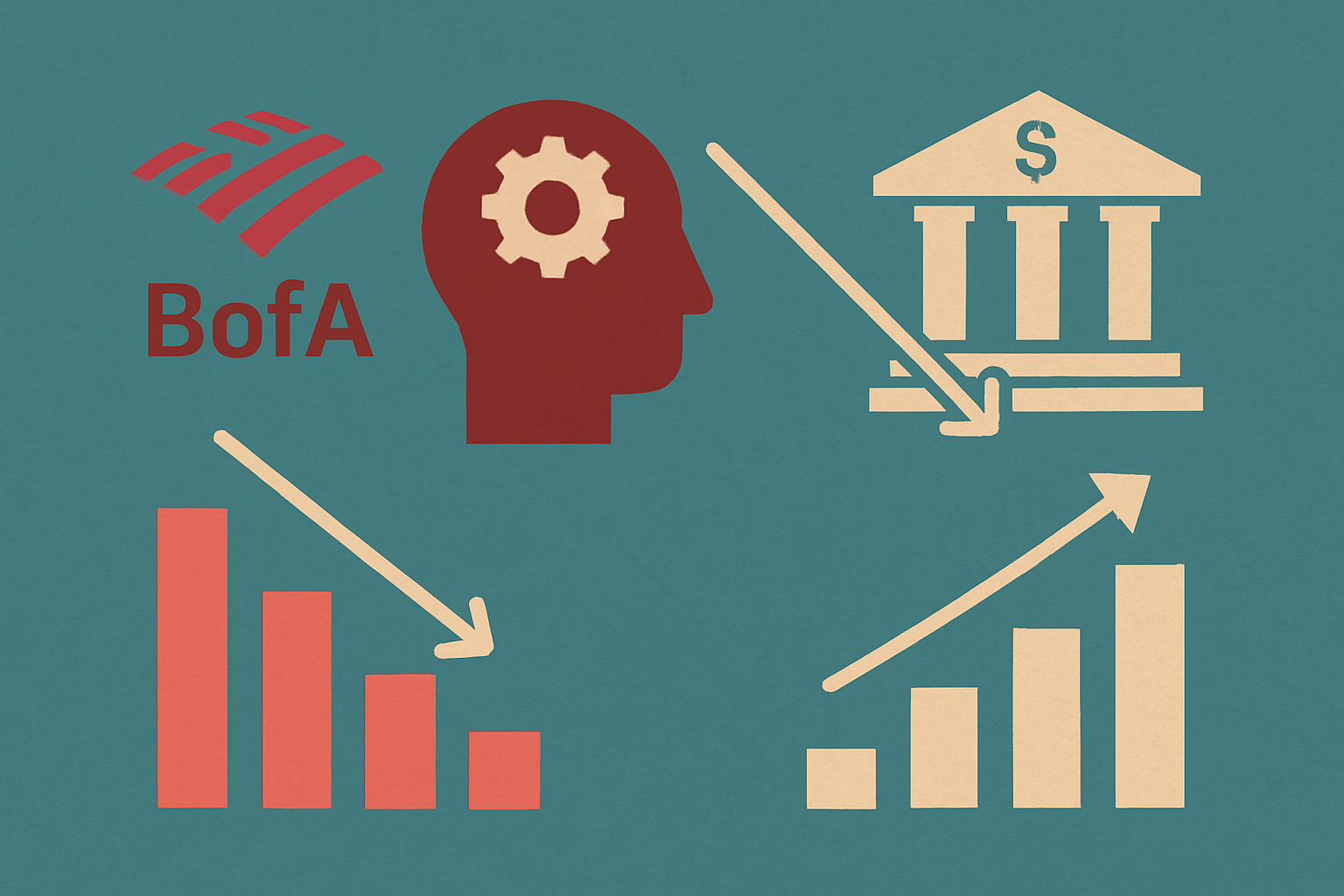Introduction
Bank of America Global Research announced that it has moved forward its projection for the next U.S. Federal Reserve interest rate cut, now expecting it to occur in October instead of December. This adjustment reflects the evolving assessment of U.S. economic conditions, particularly labor markets, and carries significant implications for financial markets, borrowers, savers, and monetary policy.
Bank of America’s revised outlook remains relatively conservative compared to other major financial institutions. It expects just one 25‑basis‑point rate cut this year, while several other firms anticipate two cuts, one in October and another in December. The decision to adjust the forecast suggests that recent labor market data and other economic signals indicate a cooling trend sufficient to justify easing monetary policy, even if certain traditional indicators are delayed or incomplete.
What Changed: Softening Labor Data And Delayed Signals
Labor Market Signals Tilt Softer
A primary driver behind the revised forecast is evidence of softening labor market conditions. With the official nonfarm payroll report delayed due to the government shutdown, analysts are increasingly relying on secondary indicators such as private payroll trackers, worker separations, initial unemployment claims, and hiring surveys. Some of these metrics suggest a slowdown in hiring and reduced wage pressures.
Bank of America’s analysis indicates that this labor market trend is sufficient to justify a rate reduction. Softening labor conditions generally reduce inflationary pressures, providing central banks with room to cut interest rates without risking immediate overheating of the economy.
Data Gaps from Government Shutdown
The ongoing U.S. government shutdown has disrupted the release of official economic data, including employment and productivity figures that are typically central to the Federal Reserve’s policy decisions. This creates additional uncertainty and forces analysts and policymakers to rely on alternative, sometimes noisier data sources. The reliance on these secondary indicators increases the risk of misjudgment in assessing the economy’s true condition.
Risks of Over‑Easing
While the case for a rate cut is supported by moderating labor market indicators, Bank of America cautioned about the dangers of over‑easing. Excessive or premature cuts could reignite inflation or reduce the Fed’s credibility in maintaining price stability. Policymakers must balance supporting economic growth with the need to keep inflation under control, a delicate task complicated by incomplete data.
Comparing Forecasts: BofA vs. Peers
Bank of America is somewhat conservative in comparison to other major financial institutions. While it projects only a single 25‑basis‑point cut in 2025, other firms anticipate two cuts, one in October and another in December. These institutions are basing their forecasts on the assumption that labor market weakness and moderate inflation will persist, providing the Federal Reserve with more room to ease policy.
The divergence in forecasts reflects the uncertainty created by delayed official data and differing interpretations of secondary indicators. Investors, meanwhile, are largely pricing in two cuts, demonstrating broader market expectations of a more aggressive easing cycle. This divergence highlights the challenges in predicting Federal Reserve actions during periods of incomplete or volatile economic data.
Implications For Financial Markets
Bond Yields and Interest Rates
Expectations of an earlier rate cut generally exert downward pressure on bond yields. Lower interest rates reduce borrowing costs and increase liquidity in the economy. However, if rate cuts do not materialize as expected or are smaller than anticipated, bond markets may experience volatility as yields adjust to new information.
Equity Markets
Lower interest rates tend to benefit equities, particularly growth and high-valuation stocks that are sensitive to discount rates. Investors may view an earlier Fed cut as supportive of economic growth and corporate earnings. Nevertheless, markets remain sensitive to inflation and economic signals, and unexpected developments could trigger volatility.
Currency and Global Investment Flows
A reduction in U.S. interest rates could weaken the U.S. dollar relative to other currencies, potentially boosting exports and commodity prices. Lower yields may also encourage investors to seek higher returns in emerging markets or riskier asset classes, affecting global capital flows.
Macro And Policy Risks
Inflation Persistence
One of the key risks for the Federal Reserve is persistent inflation. Wage pressures, supply chain disruptions, and commodity price volatility can keep inflation elevated. Premature rate cuts in such an environment could compromise the Fed’s inflation-fighting credibility.
Data Volatility and Uncertainty
Reliance on alternative labor and economic indicators increases the risk of misinterpretation. These measures may be noisier or less comprehensive than official data, making accurate forecasting more difficult and heightening the potential for policy missteps.
Credibility and Communication
The Federal Reserve’s credibility is central to maintaining stable financial markets. Policymakers must clearly communicate the rationale for any rate cuts and ensure markets understand the conditional nature of policy decisions. Miscommunication could amplify market volatility and undermine confidence.
What Does This Means For Households And Businesses?
Borrowing Costs
An earlier rate cut could reduce borrowing costs for households and businesses, particularly for variable-rate loans and mortgages. Lower interest rates may encourage refinancing, new investments, and consumption, benefiting overall economic activity.
Savings and Fixed-Income Returns
Conversely, savers and investors in fixed-income instruments may face lower returns. Traditional safe assets, such as savings accounts, certificates of deposit, and bonds, could provide reduced yields, prompting a search for alternative investments with higher returns.
Investment Behavior
Expectations of lower interest rates generally lead to increased allocation toward equities, real estate, and other risk assets. Households may adjust investment portfolios accordingly, but they should remain mindful of potential market volatility.
Inflation and Cost of Living
Even if interest rates decline, persistent inflation could erode real purchasing power. Households may experience continued pressure on food, energy, housing, and other essential expenses, requiring careful financial planning.
The Mechanics And Likely Course Ahead
What the Federal Reserve Might Do?
Given current data trends and market expectations, the Fed may deliver a 25-basis-point rate cut in October if labor and inflation indicators support the move. Decisions about additional cuts later in the year will depend on ongoing economic developments, including inflation, employment, consumer spending, and global conditions.
Possible Scenarios
Soft Landing: Moderate labor market cooling and controlled inflation allow the Fed to cut rates without destabilizing the economy.
Sticky Inflation: Inflation remains elevated, forcing the Fed to delay cuts or pause easing, potentially creating market volatility.
Data Surprises: Incomplete or noisy data may lead to misjudgment in timing cuts, resulting in unexpected market reactions.
Key Indicators to Monitor
- Employment metrics, including job growth and unemployment.
- Inflation data, including core and headline indexes.
- Consumer spending and retail activity.
- Industrial, manufacturing, and services sector performance.
- Global economic trends and geopolitical risks.
- Federal Reserve communications and forward guidance.
Broader Implications And Takeaways
Shift in Monetary Policy Narrative
Moving the projected rate cut from December to October signals a more responsive Fed, willing to act sooner if conditions warrant. This adjustment reflects sensitivity to labor market changes and evolving inflation dynamics.
Market Expectations
Market participants largely expect two cuts, reflecting optimism about the economy and the Fed’s willingness to ease. This may support risk asset valuations but also increases exposure to potential volatility if expectations are unmet.
Risks to Credibility
The Fed must navigate incomplete data and communicate policy clearly to maintain market confidence. Missteps could damage credibility and increase financial instability.
Structural Versus Cyclical Challenges
While rate cuts can address cyclical economic weaknesses, structural issues such as inequality, productivity trends, and demographic shifts remain beyond the reach of monetary policy. Households and businesses must account for these broader challenges in financial planning.
Conclusion
Bank of America’s decision to advance its Fed rate cut forecast underscores the uncertain and evolving economic landscape. Moderating labor markets, delayed data releases, and inflation dynamics have combined to support the case for an earlier rate cut, though risks remain.
For households and businesses, this could mean lower borrowing costs, reduced yields on safe assets, and increased investment opportunities, tempered by potential inflation pressures and market volatility. The coming months will be pivotal in determining whether these expectations are realized and whether the Federal Reserve can successfully navigate a delicate balance between supporting growth and maintaining price stability.

